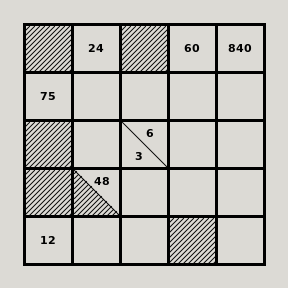Author: Anders Holst ([email protected])
This game is a factor crossword, i.e. the grid should be filled with numbers such that the products of them match the horizontal and vertical clues. It is similar to kakuro, but with multiplication instead of addition, and there is no rule against repetition of numbers, so the same factor can occur several times in a product.
I encountered this puzzle in a book on number games when I was a kid (Carl-Otto Johansen, "37+53 number games", 1980, in Swedish). The book also contained some tricks for mental arithmetic, such as how to check divisibility with different numbers. I have never seen this puzzle anywhere else. But if you are not scared of numbers and math, it is quite enjoyable. And as a side effect, you will quickly learn how to do prime factorization of large numbers in the head.
Factorcross shares much of its control system with other games where you fill in numbers in squares, such as Solo, Unequal, Towers, Keen, etc.
To play Factorcross, (left) click the mouse in a square and type in a number. You can erase the number in a selected square by pressing space.
If you right click in a square, you can add a pencil mark. You can add several pencil marks in a square, but not more than one of each number. If you try to add the same number twice, it will erase that number instead. Space in a selected square erases all pencil marks.
Pressing M will fill in a full set of pencil marks in every square that does not have a main digit in it.
The game pays no attention to pencil marks, so exactly what you use them for is up to you: you can use them as reminders that a particular square needs to be re-examined once you know more about a particular number, or you can use them as lists of the possible numbers in a given square, or anything else you feel like.
As for the other similar games, the cursor keys can be used in conjunction with the digit keys to set numbers or pencil marks. Use the cursor keys to move a highlight around the grid, and type a digit to enter it in the highlighted square. Pressing return toggles the highlight into a mode in which you can enter or remove pencil marks.
(All the actions described in common-actions the SGT puzzles docs
are also available.)
In addition to the above controls, you can also use H to toggle hints mode. If you select a clue square in hints mode, the game will show you the prime factorizations of both the vertical and horizontal clue in that square. Use restrictively, since it may remove some of the fun of the game...
These parameters are available from the Custom... option on the
Type menu.
Grid size
Size of grid in squares (not counting the pure clue lines at the left and the top). The grid size can be between 2 and 15.
Zeroes allowed
Allow zeroes in the puzzle. This makes it a little trickier. Not in finding the positions of the zeroes, because that is trivial, but because the slots in the same rows/columns will lose one of their clues.
No ones allowed
No ones are allowed in the puzzle. You must household with your factors so you have them for all squares. The board is generated so that this condition will have to be explicitly considered to be able to find the unique solution.
Limited clue size
For beginners, make sure that the clues are not too large numbers. The exact limit depends on the size of the board.
Maximum value
Specifies the highest number allowed in the squares. Using higher numbers than 9 will introduce more prime factors, and also more ways to factor old familiar products. The maximum can vary between 5 and 20.
